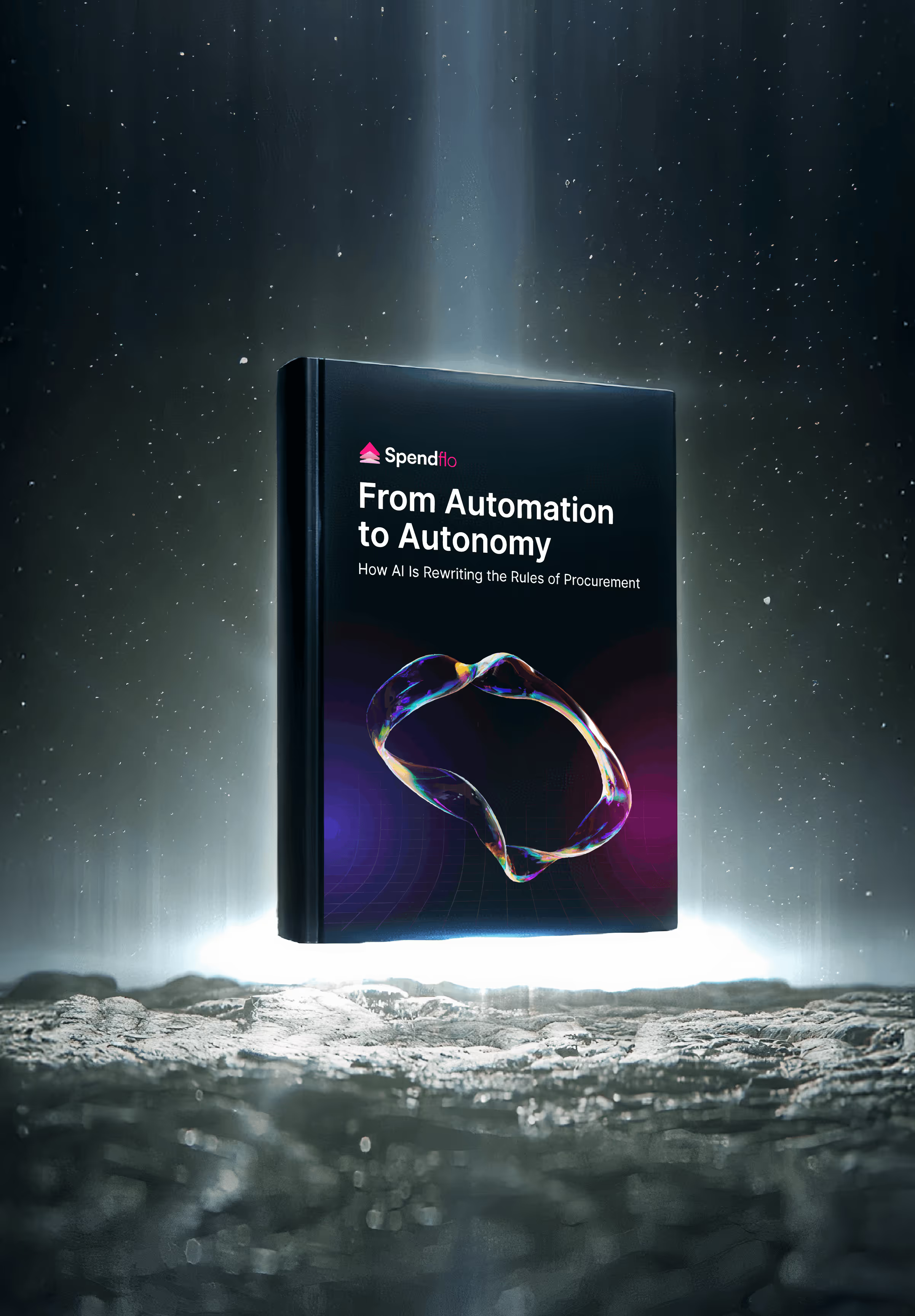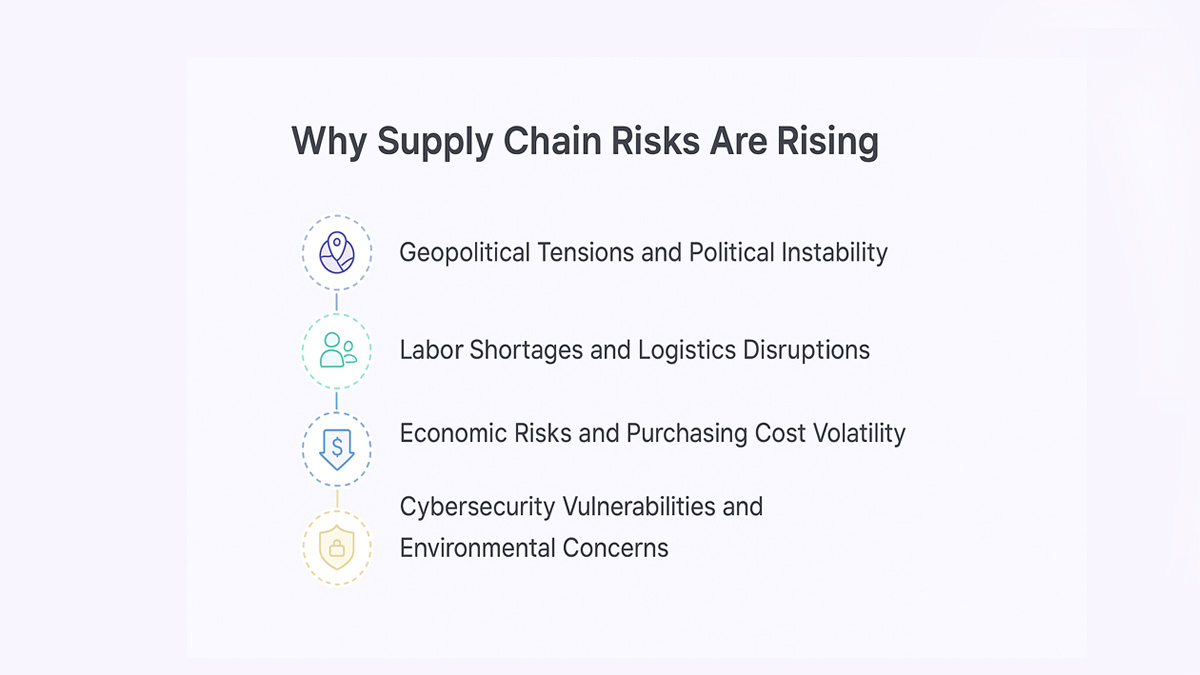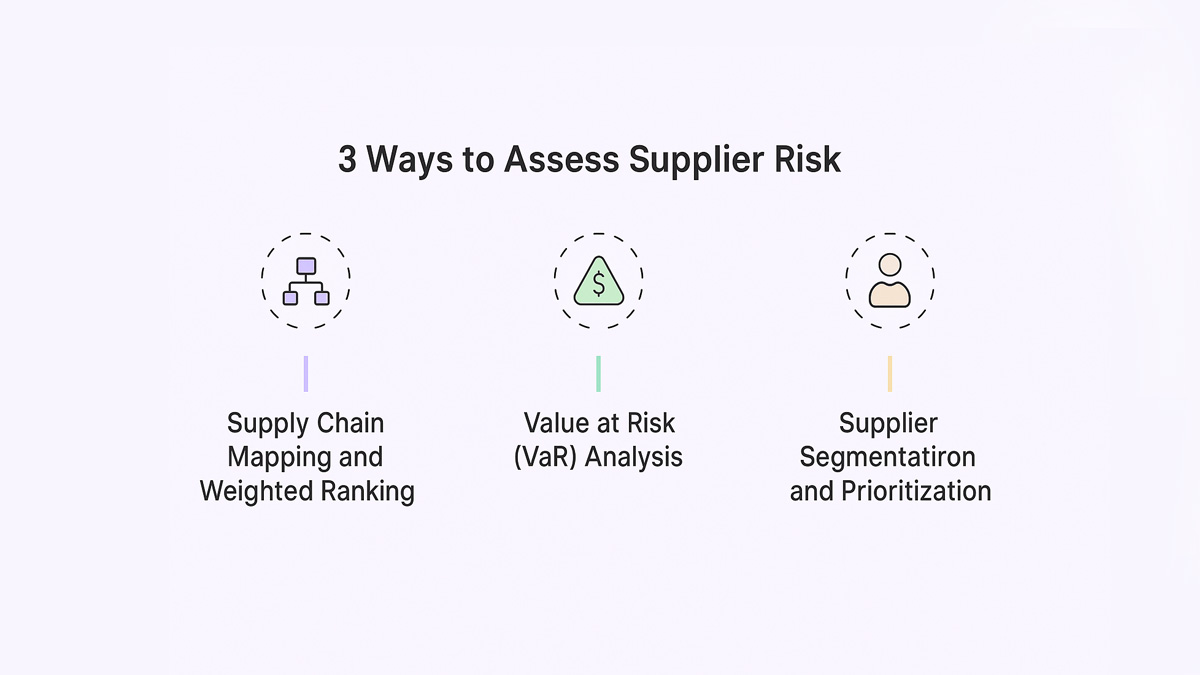

Top Supply Chain Risks and How to Mitigate Them

Top Supply Chain Risks and How to Mitigate Them
Learn the top supply chain risks of 2025 and how to mitigate them through automation, diversification, and strategic risk management.


A single delay. One disrupted shipment. It’s all it takes to throw your supply chain into chaos. From geopolitical flashpoints to unexpected factory shutdowns, today’s supply chains face more threats than ever before. Leaders can no longer afford to wait and react - they need to be prepared, proactive, and resilient.
What this blog covers:
- Understanding supply chain risks in 2025
- Why supply chain risks are rising – and what it means for you
- How to assess supplier risk: 3 proven strategies
- 7 effective ways to mitigate supplier risk
- Reducing supply chain risk through automation with Spendflo
- How Spendflo helps with supply chain risk mitigation
- Frequently asked questions on mitigating supply chain risk
What is Supply Chain Risk?
Supply chain risk refers to the potential for disruptions that impact the flow of goods, services, or finances within a supply network. These risks can arise from natural disasters, geopolitical issues, cyberattacks, supplier failures, or logistical challenges across global operations.
Why Supply Chain Risks Are Rising
Not long ago, supply chains were built for efficiency - now, they’re being rebuilt for survival. From the ripple effects of COVID-19 pandemic to the war in Ukraine and Red Sea shipping disruptions, global events have made one thing crystal clear: fragility is the norm. Robust supply chain management is now essential to navigate this new normal.

Geopolitical Tensions: Countries are revisiting trade policies, enforcing stricter export controls, and grappling with shifting alliances. Sanctions, tariffs, and border delays are disrupting cross-border movement of goods and raw materials.
Labor And Logistics Disruptions: Warehouses are understaffed. Drivers are in short supply. And the rise of e-commerce has only increased the pressure on last-mile delivery, especially for time-sensitive goods. The Internet of Things is helping improve visibility across warehouses and fleets.
Economic Risks: Inflation, fluctuating currencies, and supply-demand mismatches are forcing businesses to reevaluate their procurement strategy. Financial risks are growing as interest rates and raw material costs rise. SMBs, in particular, are vulnerable to rising purchasing costs and longer cash conversion cycles.
Cybersecurity And Environmental Threats: Attacks on third-party logistics (3PL) providers and warehouse management systems are increasing. Meanwhile, natural disasters - from wildfires to floods - continue to disrupt operations with growing intensity and frequency. These environmental risks are expected to intensify in the coming years.
The stakes are high. For operations managers, C-suite leaders, and warehouse teams alike, recognizing these risks isn’t enough anymore - managing them proactively is the only way forward.
How to Assess Supplier Risk: 3 Proven Strategies
You can’t mitigate what you can’t see. And when it comes to your suppliers - especially the critical ones - visibility is everything. Before jumping into risk mitigation, companies need a solid grasp on which suppliers pose the biggest threat, and why.
Here are three reliable strategies that help organizations evaluate supplier risk with greater clarity and confidence:

Supply Chain Mapping and Weighted Ranking
Start by mapping your full supplier network - not just Tier 1, but as deep into the chain as you can reasonably go. Think of it like drawing your supplier family tree. From there, assign a weighted risk score to each based on factors like region, lead time sensitivity, dependency, and past performance. This creates a clear picture of your most vulnerable links.
Why it works: This method doesn’t treat all vendors equally. It helps operations managers focus on where disruption would hurt the most - whether that’s a sole-source supplier in a politically unstable region or a vendor that accounts for 40% of a key component.
Value at Risk (VaR) Analysis
Borrowed from the world of finance, Value at Risk quantifies potential loss if a specific supplier fails. You calculate the dollar impact based on purchasing volume, replacement cost, and delay duration. It's particularly useful for C-suite leaders looking to justify risk mitigation investments with hard numbers.
Why it works: VaR brings objectivity to what’s often a subjective process. It transforms supplier risk into financial exposure - something that finance and leadership teams can align around quickly.
Supplier Segmentation and Prioritization
Segment suppliers by their strategic importance: critical, important, or transactional. Supplier evaluation frameworks should consider performance, reliability, and compliance. Then layer in risk dimensions like geographic exposure, cybersecurity readiness, and ESG compliance. Cybersecurity risks should be a top concern, especially for digital-first supply chains. From here, it becomes easier to create differentiated engagement models - one-size-fits-all just won’t cut it anymore.
Why it works: Segmentation allows for more tailored strategies. Organizations should embed risk management strategies across procurement and operations. You can monitor high-risk vendors more closely, push for redundancy where needed, or even reconsider partnerships that no longer align with your operational or ethical standards.
7 Effective Ways to Mitigate Supplier Risk
Identifying supplier risk is only the first half of the battle - the real challenge is doing something about it. Mitigation isn’t a one-time fix; it’s an ongoing discipline. it’s an ongoing discipline. Small, targeted moves can make a big impact.
Here are seven effective strategies you can start deploying today:
1. Build Stronger Supplier Relationships
Trust isn’t just a soft skill - it’s a risk buffer. Maintain regular, transparent communication with key suppliers. Share forecasts, align on expectations, and conduct joint planning sessions. When issues arise, those with stronger supplier relationships are first to get the call - and often, first to get the goods.
2. Diversify Your Supplier Base
Relying too heavily on one supplier - or even one region - is like playing procurement roulette. Spread your risk by building a broader vendor portfolio across geographies and tiers. Even having a “Plan B” supplier lined up can be a game-changer during disruptions.
3. Use Scenario Planning for Disruption Readiness
Think of it like fire drills for your supply chain. Run through “what if” situations: What happens if Port X shuts down? Or if Vendor Y gets hit with a cyberattack? Identify backup actions in advance, so your team isn’t scrambling when a real crisis hits. Every company should have a Business Continuity Plan tied to supplier disruption.
4. Improve Inventory Management Practices
Buffer stock is back in fashion - for good reason. While just-in-time models cut costs, they also cut resilience. Smart inventory management blends efficiency with flexibility. Monitoring Inventory Levels closely can help respond faster to unexpected demand shifts. This might mean increasing safety stock for high-risk items or using demand-sensing tools to adjust inventory more accurately.
5. Leverage Technology for Early Risk Detection
Use digital tools for real-time supplier monitoring - from financial health scores to shipment delays and even social sentiment tracking. Advances in digital technology have made risk prediction faster and more accurate. Artificial intelligence is increasingly used to detect and predict disruptions in real time. Some platforms flag supplier issues the moment they hit the news or regulatory radar. Early warnings give you a crucial head start.
6. Implement Ethical and Sustainable Sourcing
Child labor, forced labor, and environmental violations don’t just damage reputation - they can also trigger legal, financial, and operational fallout. Failing to vet suppliers for ESG violations can also lead to reputational risk. Build due diligence into your onboarding and audits, and don’t be afraid to walk away from risky suppliers, even if they’re cheaper.
7. Train Internal Teams on Risk Response
Risk management isn’t just a procurement function. Warehouse managers, finance teams, and operations leads should all understand the protocols for supplier disruption. Cross-functional drills, shared playbooks, and clear escalation paths help ensure fast, coordinated responses.
Each of these tactics strengthens your supply chain’s resilience - not just on paper, but in the real world, where surprises are the only certainty.
Reducing Supply Chain Risk Through Automation With Spendflo
The more manual your procurement process is, the more room there is for things to go wrong - missed contract renewals, untracked vendor risks, forgotten approvals. It’s not just inefficient. It’s risky.
That’s where automation changes the game.
With Spendflo, businesses can streamline and de-risk their supplier workflows from intake to renewal. Imagine this: real-time alerts for upcoming contract deadlines, instant visibility into your SaaS and vendor spend, and centralized data that eliminates shadow procurement. No more flying blind - or rushing to fix something when it’s already broken.
Track and manage supplier data in one place
Supplier contracts, pricing terms, renewal timelines - all centralized. This makes it easier to track performance and spot anomalies before they become costly issues.
Enable automated approval workflows
Manual handoffs slow things down and introduce human error. Spendflo automates multi-level approvals, ensuring every purchase goes through the right checks without bottlenecks.
Gain visibility into spend by supplier, category, and risk
Know exactly where your dollars are going, and which vendors are over-indexed.
This visibility allows for quicker course correction and better vendor diversification decisions.
Connect procurement to finance and operations
No more silos. Automation keeps procurement aligned with budget owners, warehouse managers, and leadership - ensuring continuity, even when the pressure is on.
Supply chain disruptions aren’t going away anytime soon - but automation gives your business the agility and intelligence to stay one step ahead.
Frequently Asked Questions on Mitigating Supply Chain Risk
What are the biggest supply chain risks in 2025?
The top risks include geopolitical instability, labor shortages, cybersecurity threats, climate-related disruptions, and over-reliance on single suppliers or regions. These factors can lead to delays, increased costs, or complete operational standstills if not addressed proactively.
How can small and midsize businesses reduce supply chain risk?
SMBs can start by diversifying vendors, automating procurement workflows, and monitoring supplier performance. Tools like Spendflo help track contracts, flag risks early, and reduce dependency on high-risk vendors - without needing a large in-house procurement team.
What technologies help with supply chain risk mitigation?
Procurement automation platforms, supply chain mapping tools, and real-time analytics dashboards are essential. These technologies provide early alerts, track vendor behavior, and offer actionable insights to reduce disruption before it impacts operations. Supply chain analytics helps forecast risk patterns and optimize decision-making. IoT devices enable real-time tracking of goods and equipment across supply networks.
How do supplier relationships impact risk exposure?
Strong supplier relationships lead to better transparency, faster conflict resolution, and greater flexibility during disruptions. Vendors are more likely to prioritize loyal, communicative partners when supply is tight or demand spikes unexpectedly.
Can automation really reduce supply chain delays?
Yes - automation speeds up everything from approvals to renewals. It removes manual bottlenecks, ensures compliance with procurement policies, and helps detect risks early. With tools like Spendflo, businesses can act before delays spiral into larger operational issues.










.png)




.png)










.avif)





